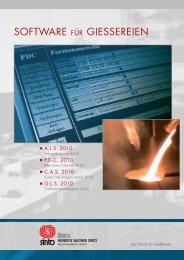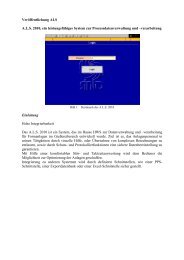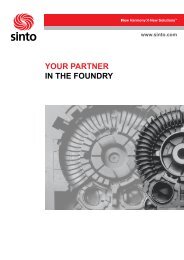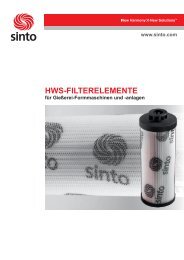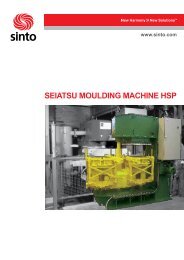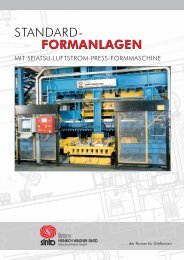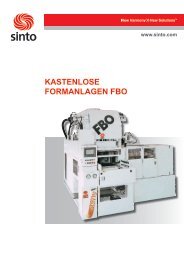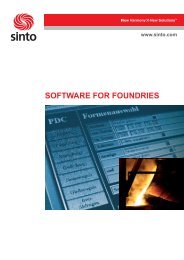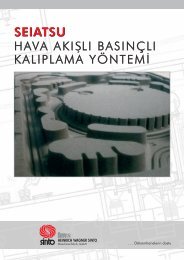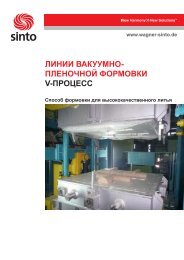SOFTWARE FOR FOUNDRIES - Heinrich Wagner Sinto
SOFTWARE FOR FOUNDRIES - Heinrich Wagner Sinto
SOFTWARE FOR FOUNDRIES - Heinrich Wagner Sinto
You also want an ePaper? Increase the reach of your titles
YUMPU automatically turns print PDFs into web optimized ePapers that Google loves.
MODERN CONTROL CONCEPTSTHE hws <strong>SOFTWARE</strong> LABThe hws software team develops up-to-date controlconcepts for the moulding plants designed in ourhouse in order to achieve the highest possibleefficiency in production and to optimize theproduction quality and plant availability.Used are the latest control hardware componentsof Siemens – from the intelligent servo-converter viathe central control with decentralized periphery upto the operator’s panel.Programming at hws is done by keeping a highdegree of standardization so that a quick supportis possible at any time.The basic software A.L.S. 2010, in the meantimea standard in nearly every moulding plant, comprisesimportant basic functions for fault analysis and dataadministration.Furthermore, the software components P.D.C. 2010and C.A.S. 2010 provide the possibility of a moredetailed acquisition of information and analysis.
THE <strong>SOFTWARE</strong> COMPONENTSA.L.S. 2010Production Monitoring System 2010C.A.S. 2010Cycle Time Analysis System 2010P.D.C. 2010Plant Data Collection 2010G.L.S. 2010Pouring Machine Monitoring System 2010
The main area Administration makes functions for the administrationof the production process available. Besides the creationof new pattern parameters and its process parameters inthe pattern administration, the operator can make use of acomfortable shift management system for administration andanalysis of production shifts.Main area StatisticsThe possibility of a systematic analysisof events and cycle time exceedings inthe area Statistics helps to optimize themoulding plant in order to achieve ahigher plant availability. A maintenancesystem depending on the operatinghours or basic cycles enables the operatorto perform precise maintenanceworks.Main area AdministrationMain area StatisticsMODULAR STRUCTUREThe A.L.S. 2010 has a modular concept which allows anextension of the system from the basic version up to thecomplete version, depending on the requirements.Both versions A.L.S. 2010 WEB and A.L.S. 2010 Lightcontain the software modules shown in the picture. The essentialdifference between both versions is the network capability,the A.L.S. 2010 WEB being designed for network operationand the A.L.S. 2010 Light as a single-terminal solution.Content and structure of the softwareLatest technologies, such as the automatic transmission of a callin case of plant standstill, integration of plant cameras as wellas the operation by mobile operating units, are part of themodules in the A.L.S. 2010.ADVANTAGES:• Increasing of the plant availability due to detailedfault analyses• Increasing of the quality assurance due to accesssecurity, monitoring and recording of the process data• Constant mould results due to a recipe administration• Comfortable production organization due to aproduction list• Specific preventive maintenance due to the acquisitionof maintenance intervals• Preparation of process data for presentation withMicrosoft Office software• Production planning and evaluation of higher-level systems(SAP, SD)• Transfer of process and production data to an exportdatabase• Support of operating personnel due to optimization andmonitoring (e. g. of the cooling lines or sprue cup drillercoordinates)• Quality assurance due to provision, reproduction, distributionand monitoring of quality-relevant process parameters
P.D.C. 2010 – AN INNOVATIVE SYSTEM <strong>FOR</strong> THECENTRAL ACQUISITION OF ALL PRODUCTION DATA.P.D.C. 2010 (Plant Data Collection)In many foundries, archiving of process parameters is stillrealized in writing by hand or by different analysis records onpaper created separately. This technology of data acquisitionand data saving is very time-consuming on the one hand andunsafe and inaccurate upon archiving on the other hand.This outdated method offers, if at all, very limited possibilitiesfor specific searching for causes of quality problems or forestablishing product reports as well as for the exact identificationof a casting.hws, with the experience of 435 SEIATSU moulding machinesand/or plants supplied and started-up worldwide, developedtherefore a system that makes the complex sequence visible inview of the data technology and thus offers optimal possibilitiesfor quality inspection and process optimization.Starting menue of P.D.C. 2010INTEGRATION INSTEADOF SPOT SOLUTIONThe P.D.C. 2010 is a web-based system with an interfaceto the Intranet or Internet, by which programmingis effected according to the latest Internet technologieslike .NET, ASPX, XML/XSLT, HTML, OPC. In this case,the data acquisition is monitored and recorded byPC- and PLC-sided test routines.The system, which is installed in a PC control cabinet,consists of the P.D.C. 2010 server (operating systemWindows XP) with a data saving drive and a printer.Power failures will be short-circuited by means ofa UPS.By a communication installed in an actuator/sensorlevel between the different process plants, like sandpreparation, core making, pouring machine, castingseparation or melting shop, all process data to berecorded will be collected in the hws control andmade available to the P.D.C. 2010 server by a datatransfer line, the data of systems without field bus interfacebeing read in by a defined ASCII interface.The raw data stored in the production database willthen be made available to the operator in a comfortablyaccessible way. If there is an interface to thecompany network, it is everywhere possible to accessthe data without any further software installation.System architecture of P.D.C. 2010
MOUSE CLICK INSTEAD OF PAPERWORKThe P.D.C 2010 is a multilingual system with an easily operator-controllable,graphic surface. As done in Internet applications,control is realized in the Internet Explorer by mouse or keyboard.The following interrogation criteria are possible: timeperiod for report display, min/max values for fault analysis orsystem optimization and identification ofspecific castings.Interrogation and display selectionAfter input of the requested criteria, e.g.time stamp and pattern number, the userhas the possibility to receive via themouse in the display more detailed informationfor each indication.This information is displayed in tabularform or XML structure and is available tothe user as such for Microsoft Officeapplications.Printing is realized directly via thebrowser or by list printing in the crystalreport. An export via a XML interfaceand Microsoft Excel is also possible.Display of the production dataCONCISE DATA INSTEAD OFDATA GRAVEYARDThe P.D.C. 2010 guarantees the acquisition of productiondata both for each indexed mould and for different batches.Possible is the acquisition of the moulding data, core data,pouring data, melting data, analysis data etc.Data saving is possible up to one year. After this period,it is possible to file the data on external storage mediums.Detailed display per mouse clickADVANTAGES:• Independent acquisition system• Maintenance-free and manipulation-safe database• Physical separation of PC/PLC, control andmonitoring possible• XML platform-independent description of the data• Quick updatability (only server-sided modificationrequired)Content and structure of the software
C.A.S. 2010 – AN ANALYSIS SYSTEM<strong>FOR</strong> CYCLE TIME AND DRIVE DIAGNOSTIC.C.A.S. 2010 (Cycle Time Analysis System)A system which enables, in case of moulding plantswith cycle time problems, the recognition of causes byan analytical process. These problems primarily occurdue to sequential faults, e.g. by incorrect moulding boxposition in plants which are partially extremely nestedor by time-out faults of the drives which might arise dueto incorrect proportional settings.Normally, sequential faults may occur during the commissioningphase only, whereas time-out faults may alsodevelop during this phase, but mostly during runningoperation.Starting menue of C.A.S. 2010FUNCTION AND TARGET GROUPThe starting and running times of all drives are establishedcyclically and stored in a XML data structure.These data can be displayed in a chart or in tabularform and analysed for optimization purposes.By selective interrogations of the user, all data areavailable to him transparently. Thanks to the directcomparison with a statically stored time-travel diagram,it is possible to recognize sequential and time-out faultsby a comparison of the setpoint and actual values.Due to the determination of the running times, it ispossible to identify both too slow drives and too fastdrives. This is important for setting the drives in orderto neither lose any cycle time nor to consumetoo much unnecessary energy.TECHNOLOGYThe C.A.S. 2010 is a web-based system with an interfaceto the Intranet or the Internet, programming being effectedaccording to the latest Internet technologies such as .NET,ASPX, XML/XSLT, HTML, OPC. This system -– which includesa mobile laptop computer with adapter – may be operatedfor evaluation both online at the moulding plant and offlineoutside the moulding plant.The C.A.S. 2010 provides a unidirectional link to the PLC.Data are only read, and the whole “counting process” is notrealized in the PLC, but on the PC and does therefore notstrain the PLC. The transmission speed in case of 500 drivesis approx. 100 ms, i.e. resolution is achieved within1/10 second.In turn, recorded drives and cycles of running mouldingplants provide a good feedback to the technicaldepartment for verification and review of time-traveldiagrams.This program is capable to record a modification of themoulding plant traversing parameters by the operatorsand the related fluctuations of cycle time and makethem accessible to hws and the maintenance personnel.Display, supervision and recording of all available parametersof the hydraulic system (system pressure, accumulator,connection of pumps) depending on the cycle andthe movement of drives are also tasks of this system.Another function is a more precise simulation of the PLCprogram in our laboratory before commissioning basedon real drive times according to a defined time-traveldiagram, with supervision of the PLC signals as well asrecording of the cycle time.The target group of this system is the repair personnelof moulding plants. Even the programmers and/or thetechnical service may profit from this software.System architecture of C.A.S. 2010
CONTROLThe C.A.S. 2010 is a multilingual system with an easilyoperator-controllable, graphic surface. As done in Internetapplications, control is realized in the web browser by mouseor keyboard. The following interrogation criteria are possible:time period for cycle time display, min/max values foranalysis in case of cycle time fluctuations.Graphic display cycle time curveAfter input of the requested criteria, e.g.time period and cyle time exceedings,the operator will receive detailed informationfor each cycle with the mouse inthe cycle time curve.This information is displayed in graphsor in tabular form and is also availableto the user as such for Microsoft Officeapplications.Representation of the time-travel diagramas setpoint/actual display or theirdifference related to the cycle is donein graphic or in tabular form.Graphic display time-travel diagramBesides the setpoint/actual cycle timeindication, all drives are displayed withthe moment of motion start and the motionduration as setpoint/actual comparisonand their deviation. In case of exceedingor underrun of the cycle times and thedrive running times, these are underlayedwith colour.Tabular display of cycle time curve
G.L.S. 2010 – A SYSTEM <strong>FOR</strong> DATA ADMINISTRATIONAND DATA PROCESSING AT POURING MACHINES.G.L.S. 2010 (Pouring MachineMonitoring System)The G.L.S. 2010 is a system which has particularly beendeveloped for data administration and data processingat pouring machines. It assists the plant personnel in itsactivities by displaying all important process parameters,e.g. pouring weight, pouring time and temperature,as well as by representing moulding box information ofthe moulds located in the pouring section.Important functions, such as a comfortable managementof the pouring parameters, an analysis of the downtimesand cycle times including a detailed quantity recordingassist the operator in obtaining an optimum machineoperation.Starting menue of G.L.S. 2010If pouring is realized fully automatically, a one hundredper cent repeating accuracy of the pouring parametersmust be guaranteed at the pouring machine in case ofa pattern change. Via a data communication to the controlsystem of the moulding plant, a pattern-specific pouringprogram is loaded with the help of the pattern numbertransmitted, and the fully automatic pouring processis started with these regulation and control parameters.The whole pouring process can be observed with acamera. For a posterior evaluation of the process,the pouring sequences are available in the archivesand can be analysed.An integration into other systems is ensured by definedinterfaces, such as a MRP interface (MRP = manufacturingrequirements planning), an export database, an Excelor a XML interface.System architecture of G.L.S. 2010<strong>Heinrich</strong> <strong>Wagner</strong> <strong>Sinto</strong> Maschinenfabrik GmbHBahnhofstraße 101 · D-57334 Bad Laasphe, Germany, Phone +49(0)27 52/9 07-0 · Fax +49(0)27 52/9 07-2 80info@wagner-sinto.de · www.wagner-sinto.deDIN EN ISO 9001:2000Zertifikat: 09 100 72018KONTACTAndreas.Klein@wagner-sinto.deMatthias.Dittrich@wagner-sinto.deLM · 1.000 · 06/07





